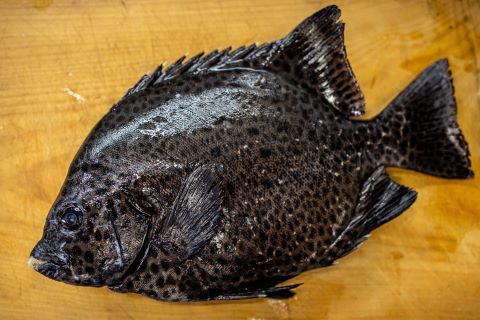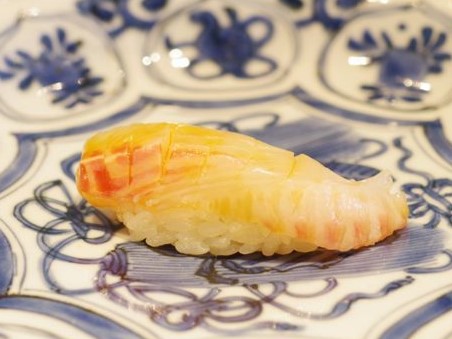
What is Spotted knifejaw (Ishigakidai)?
Spotted knifejaw (Ishigakidai) is distributed along the Pacific coast south of Ibaraki Prefecture and along the Sea of Japan south of Yamaguchi Prefecture to the South China Sea. It inhabits mainly rocky reefs. The length of the body reaches 90 cm.
The ecology and habits are similar to those of Barred knifejaw (Ishidai), but young fish are generally brownish with numerous blackish-brown stone wall (stone wall is ishigaki in Japanese) patterns scattered throughout the body. As the fish grows, the pattern becomes lighter, and in male adults it disappears completely. The season is summer.
Note that some of the larger Barred knifejaw and Spotted knifejaw (over 60 cm) may have Ciguatera poisoning. The scientific name is Oplegnathus punctatus (Temminck and Schlegel, 1844).
What does Spotted knifejaw (Ishigakidai) sushi taste like?

The meat of Spotted knifejaw (Ishigakidai) is firmer and tighter than that of Red seabream (Madai), and it is so chewy that it feels too hard to make sashimi if it has just died. Therefore, like puffer fish, usuzukuri (thinly sliced) is used for sashimi and sushi topping.
Spotted knifejaw has a more subtle scent of the sea than barred knifejaw. The color of chiai (dark red meat) is not a bright red, but rather a duller shade, but the meat is surprisingly fatty and delicious.
Nigiri sushi is also good with salt and kabosu. Its umami is thought to arise from eating sea urchins, shellfish and crustaceans. Both nigiri sushi and sashimi are rare in Tokyo, but common in Shikoku and Kyushu.
[sc_apply url=”https://sushiuniversity.jp/apply/”]
We hope this information will be helpful.

Revision date: April 26, 2023
Share this article